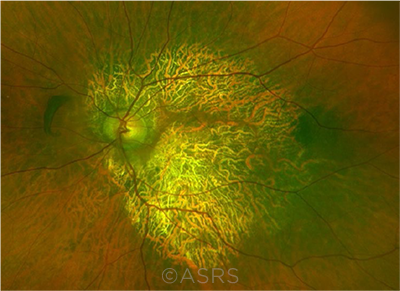Download PDF
NEI researchers have developed and validated an artificial intelligence (AI)–based method that surpasses conventional approaches to analyzing structural changes in the retina related to ABCA4-associated retinopathy, the most common form of Stargardt disease.1 Their model provides a framework for evaluating disease progression and appears to help control for the significant variability among patients for age of onset and spatial pattern of photoreceptor degeneration.
“Despite the apparent heterogeneity of patients with Stargardt disease, a simple additive model of allele severity, in conjunction with age, explains almost half of the between-patient variability in imaging-based severity,” said lead author Maximilian Pfau, MD.
 |
SHEDDING LIGHT. The presentations of Stargardt disease vary widely. Previous approaches to analyzing structural changes in the retina have not allowed researchers to correlate genetic variants with disparate disease characteristics. This image was originally published in the ASRS Retina Image Bank. Becca Harris and Liliya Sutherland, DO. Stargardt Disease. Retina Image Bank. 2021; Image Number 85107. © The American Society of Retina Specialists.
|
Homing in on the ellipsoid zone. The researchers used thickness maps of six retinal layers from OCT images of 132 eyes (66 patients) to train a deep-learning (DL) algorithm to quantify retinal degeneration over time. These images enabled the algorithm to detect patterns for quantifying and comparing loss of photoreceptors and layers of the retina that correlate ABCA4 variants with a patient’s phenotype.
Researchers focused their interest on ellipsoid zone (EZ) loss, a measure of severe photoreceptor degeneration. They also considered the outer nuclear layer beyond the areas of EZ loss. Finally, they compared measures of macula-wide photoreceptor loss, genotype, and age against the genetic data.
Outcomes. Photoreceptor losses followed predictable spatial and temporal patterns. Importantly, patients with ABCA4-associated retinopathy exhibited photoreceptor degeneration beyond the area of EZ loss. The researchers propose that this distant area may be the actual leading front of the disease.
The study also demonstrated different rates of retinal change among patients, with the age of loss dependent on genotype. Thus, the DL model generated a way of classifying the severity of 31 variants, including 16 variants not previously quantitatively analyzed for clinical severity.
Avenues for further research. Although the prediction model works well for macula-wide loss of photoreceptors, the genetic determinants of foveal sparing in Stargardt are less clearly understood and warrant further investigation, Dr. Pfau said.
With regard to potential therapies, a clinical trial of oral metformin for Stargardt is now underway at the NEI, but it was initiated before this study was published. Dr. Pfau and his colleagues plan to apply the AI-based segmentation to investigate potential treatment effects of metformin on photoreceptors distant to the EZ loss boundary.
Other therapeutic approaches to prevent progression of photoreceptor loss are underway, Dr. Pfau said. However, these therapies will only slow the deterioration of vision, not improve it, and patients will want evidence of treatment effects. “Ultimately,” he said, “it will be necessary to translate these photoreceptor loss maps to patient-relevant measures, such as reading ability and mobility.”
—Miriam Karmel
___________________________
1 Pfau M et al. JCI Insight. 2022;7(2):e155373.
___________________________
Relevant financial disclosures—Dr. Pfau: Apellis: C; Novartis: L.
For full disclosures and the disclosure key, see below.
Full Financial Disclosures
Dr. Chen UCB: C; Roche: C.
Dr. Pfau Apellis: C; Novartis: L.
Dr. Redd NEI: S; Research to Prevent Blindness: S.
Dr. Sodhi Arrowhead Pharmaceuticals: C; HIF Therapeutics: O; XCaliber Biotechnology: C.
Disclosure Category
|
Code
|
Description
|
| Consultant/Advisor |
C |
Consultant fee, paid advisory boards, or fees for attending a meeting. |
| Employee |
E |
Employed by a commercial company. |
| Speakers bureau |
L |
Lecture fees or honoraria, travel fees or reimbursements when speaking at the invitation of a commercial company. |
| Equity owner |
O |
Equity ownership/stock options in publicly or privately traded firms, excluding mutual funds. |
| Patents/Royalty |
P |
Patents and/or royalties for intellectual property. |
| Grant support |
S |
Grant support or other financial support to the investigator from all sources, including research support from government agencies (e.g., NIH), foundations, device manufacturers, and/or pharmaceutical companies. |
|
More from this month’s News in Review